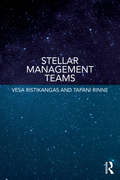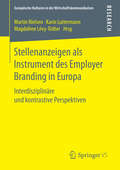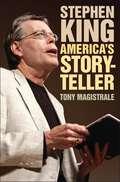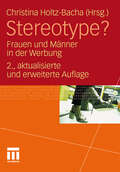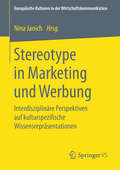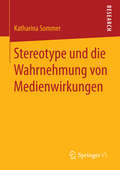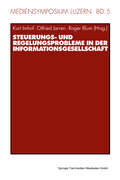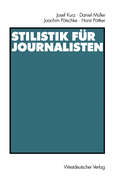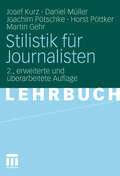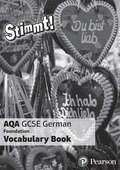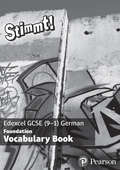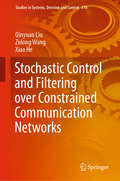- Table View
- List View
Stay Tuned: A History of American Broadcasting (Routledge Communication Series)
by Christopher H. Sterling John Michael KittrossSince its initial publication in 1978, Stay Tuned has been recognized as the most comprehensive and useful single-volume history of American broadcasting and electronic media available. This third edition has been thoroughly revised and updated to bring the story of American broadcasting forward to the 21st century, affording readers not only the history of the most important and pervasive institution affecting our society, but also providing a contextual transition to the Internet and other modern media. The enthusiasm of authors Christopher H. Sterling and John Michael Kittross is apparent as they lead readers through the development of American electronic mass media, from the first electrical communication (telegraph and telephone); through radio and television; to the present convergence of media, business entities, programming, and delivery systems, including the Internet. Their presentation is engaging, as well as informative, promoting an interest in history and making the connections between the developments of yesterday and the industry of today. Features of this third edition include: *chronological and topical tables of contents; *new material reflecting modern research in the field; *a new chapter describing historical developments from 1988 through to the current day; *an expanded bibliography, including Web site and museum listings; *an updated and expanded glossary and chronology; and *extensive statistical data of the development of television and radio stations, networks, advertising, programming, audiences, and other aspects of broadcasting. Designed for use in undergraduate and graduate courses on the history of American mass media, broadcasting, and electronic media, Stay Tuned also fits well into mass communication survey courses as an introduction to electronic media topics. As a chronicle of American broadcasting, this volume is also engaging reading for anyone interested in old radio, early television, and the origins and development of American broadcasting.
Steam-Powered Knowledge: William Chambers and the Business of Publishing, 1820-1860
by Aileen FyfeWith the overwhelming amount of new information that bombards us each day, it is perhaps difficult to imagine a time when the widespread availability of the printed word was a novelty. In early nineteenth-century Britain, print was not novel—Gutenberg’s printing press had been around for nearly four centuries—but printed matter was still a rare and relatively expensive luxury. All this changed, however, as publishers began employing new technologies to astounding effect, mass-producing instructive and educational books and magazines and revolutionizing how knowledge was disseminated to the general public. In Steam-Powered Knowledge, Aileen Fyfe explores the activities of William Chambers and the W. & R. Chambers publishing firm during its formative years, documenting for the first time how new technologies were integrated into existing business systems. Chambers was one of the first publishers to abandon traditional skills associated with hand printing, instead favoring the latest innovations in printing processes and machinery: machine-made paper, stereotyping, and, especially, printing machines driven by steam power. The mid-nineteenth century also witnessed dramatic advances in transportation, and Chambers used proliferating railway networks and steamship routes to speed up communication and distribution. As a result, his high-tech publishing firm became an exemplar of commercial success by 1850 and outlived all of its rivals in the business of cheap instructive print. Fyfe follows Chambers’s journey from small-time bookseller and self-trained hand-press printer to wealthy and successful publisher of popular educational books on both sides of the Atlantic, demonstrating along the way the profound effects of his and his fellow publishers’ willingness, or unwillingness, to incorporate these technological innovations into their businesses.
Steam-Powered Knowledge: William Chambers and the Business of Publishing, 1820-1860
by Aileen FyfeWith the overwhelming amount of new information that bombards us each day, it is perhaps difficult to imagine a time when the widespread availability of the printed word was a novelty. In early nineteenth-century Britain, print was not novel—Gutenberg’s printing press had been around for nearly four centuries—but printed matter was still a rare and relatively expensive luxury. All this changed, however, as publishers began employing new technologies to astounding effect, mass-producing instructive and educational books and magazines and revolutionizing how knowledge was disseminated to the general public. In Steam-Powered Knowledge, Aileen Fyfe explores the activities of William Chambers and the W. & R. Chambers publishing firm during its formative years, documenting for the first time how new technologies were integrated into existing business systems. Chambers was one of the first publishers to abandon traditional skills associated with hand printing, instead favoring the latest innovations in printing processes and machinery: machine-made paper, stereotyping, and, especially, printing machines driven by steam power. The mid-nineteenth century also witnessed dramatic advances in transportation, and Chambers used proliferating railway networks and steamship routes to speed up communication and distribution. As a result, his high-tech publishing firm became an exemplar of commercial success by 1850 and outlived all of its rivals in the business of cheap instructive print. Fyfe follows Chambers’s journey from small-time bookseller and self-trained hand-press printer to wealthy and successful publisher of popular educational books on both sides of the Atlantic, demonstrating along the way the profound effects of his and his fellow publishers’ willingness, or unwillingness, to incorporate these technological innovations into their businesses.
Steam-Powered Knowledge: William Chambers and the Business of Publishing, 1820-1860
by Aileen FyfeWith the overwhelming amount of new information that bombards us each day, it is perhaps difficult to imagine a time when the widespread availability of the printed word was a novelty. In early nineteenth-century Britain, print was not novel—Gutenberg’s printing press had been around for nearly four centuries—but printed matter was still a rare and relatively expensive luxury. All this changed, however, as publishers began employing new technologies to astounding effect, mass-producing instructive and educational books and magazines and revolutionizing how knowledge was disseminated to the general public. In Steam-Powered Knowledge, Aileen Fyfe explores the activities of William Chambers and the W. & R. Chambers publishing firm during its formative years, documenting for the first time how new technologies were integrated into existing business systems. Chambers was one of the first publishers to abandon traditional skills associated with hand printing, instead favoring the latest innovations in printing processes and machinery: machine-made paper, stereotyping, and, especially, printing machines driven by steam power. The mid-nineteenth century also witnessed dramatic advances in transportation, and Chambers used proliferating railway networks and steamship routes to speed up communication and distribution. As a result, his high-tech publishing firm became an exemplar of commercial success by 1850 and outlived all of its rivals in the business of cheap instructive print. Fyfe follows Chambers’s journey from small-time bookseller and self-trained hand-press printer to wealthy and successful publisher of popular educational books on both sides of the Atlantic, demonstrating along the way the profound effects of his and his fellow publishers’ willingness, or unwillingness, to incorporate these technological innovations into their businesses.
Steam-Powered Knowledge: William Chambers and the Business of Publishing, 1820-1860
by Aileen FyfeWith the overwhelming amount of new information that bombards us each day, it is perhaps difficult to imagine a time when the widespread availability of the printed word was a novelty. In early nineteenth-century Britain, print was not novel—Gutenberg’s printing press had been around for nearly four centuries—but printed matter was still a rare and relatively expensive luxury. All this changed, however, as publishers began employing new technologies to astounding effect, mass-producing instructive and educational books and magazines and revolutionizing how knowledge was disseminated to the general public. In Steam-Powered Knowledge, Aileen Fyfe explores the activities of William Chambers and the W. & R. Chambers publishing firm during its formative years, documenting for the first time how new technologies were integrated into existing business systems. Chambers was one of the first publishers to abandon traditional skills associated with hand printing, instead favoring the latest innovations in printing processes and machinery: machine-made paper, stereotyping, and, especially, printing machines driven by steam power. The mid-nineteenth century also witnessed dramatic advances in transportation, and Chambers used proliferating railway networks and steamship routes to speed up communication and distribution. As a result, his high-tech publishing firm became an exemplar of commercial success by 1850 and outlived all of its rivals in the business of cheap instructive print. Fyfe follows Chambers’s journey from small-time bookseller and self-trained hand-press printer to wealthy and successful publisher of popular educational books on both sides of the Atlantic, demonstrating along the way the profound effects of his and his fellow publishers’ willingness, or unwillingness, to incorporate these technological innovations into their businesses.
Steganography Techniques for Digital Images
by Abid YahyaThis book covers newly developed and novel Steganography techniques and algorithms. The book outlines techniques to provide security to a variety of applications using Steganography, with the goal of both hindering an adversary from decoding a hidden message, and also preventing an adversary from suspecting the existence of covert communications. The book looks into applying these newly designed and improved algorithms to provide a new and efficient Steganographic system, called Characteristic Region-Based Image Steganography (CR-BIS). The algorithms combine both the robustness of the Speeded-Up Robust Features technique (SURF) and Discrete Wavelet Transform (DWT) to achieve characteristic region Steganography synchronization. The book also touches on how to avoid hiding data in the whole image by dynamically selecting characteristic regions for the process of embedding. Applies and discusses innovative techniques for hiding text in a digital image file or even using it as a key to the encryption;Provides a variety of methods to achieve characteristic region Steganography synchronization;Shows how Steganography improves upon cryptography by using obscurity features.
Stellar Management Teams
by Vesa Ristikangas Tapani RinneManagement teams at all levels, and individual team members in particular, are often disengaged and disconnected from the management function itself. Statements such as, "we lack common goals or they are unclear", "I have no influence", "I am not listened to nor taken into account", and "I do not feel valued – actually, nobody does", are commonplace. The authors argue this is because we have been entrenched in an era of guru leadership but that it must come to an end if our management teams are to rise to the top. An individual is not capable of controlling the complicated system of an organization, with its countless variables, especially in conjunction with the rapid change in both the economy and market forces, which are unpredictable and uncontrollable. No matter how talented the individual, no one person is in a position to manage this complex system alone – not even a guru leader. The authors contend that what is needed now are resilient trendsetters who will bring about a new era of top-performing teams that together form a "collective guru", which they refer to as a Stellar Management Team. In this book, the reader undertakes a metaphorical journey to the stars, which symbolizes top-level interaction and collaboration. The journey is the development from an ordinary management team into a Stellar Management Team, which elevates its operation up to a new level of performance and success.
Stellar Management Teams
by Vesa Ristikangas Tapani RinneManagement teams at all levels, and individual team members in particular, are often disengaged and disconnected from the management function itself. Statements such as, "we lack common goals or they are unclear", "I have no influence", "I am not listened to nor taken into account", and "I do not feel valued – actually, nobody does", are commonplace. The authors argue this is because we have been entrenched in an era of guru leadership but that it must come to an end if our management teams are to rise to the top. An individual is not capable of controlling the complicated system of an organization, with its countless variables, especially in conjunction with the rapid change in both the economy and market forces, which are unpredictable and uncontrollable. No matter how talented the individual, no one person is in a position to manage this complex system alone – not even a guru leader. The authors contend that what is needed now are resilient trendsetters who will bring about a new era of top-performing teams that together form a "collective guru", which they refer to as a Stellar Management Team. In this book, the reader undertakes a metaphorical journey to the stars, which symbolizes top-level interaction and collaboration. The journey is the development from an ordinary management team into a Stellar Management Team, which elevates its operation up to a new level of performance and success.
Stellenanzeigen als Instrument des Employer Branding in Europa: Interdisziplinäre und kontrastive Perspektiven (Europäische Kulturen in der Wirtschaftskommunikation #23)
by Martin Nielsen Magdalène Lévy-Tödter Karin LuttermannDer Band versammelt Studien zum Thema Stellenanzeige aus sprach-, kultur-, marketingwissenschaftlicher und juristischer Perspektive, die eine differenzierte Herangehensweise an diese Textsorte im Rahmen des Human Resource Management ermöglichen. Untersucht werden im interdisziplinären Zusammenspiel Funktionen und Wirkungsmittel von Stellenanzeigen im europäischen Kontext des Employer Branding. Die Beiträge zeigen, dass Unternehmen im verschärften Wettbewerb um hochqualifizierte Mitarbeiter viele Möglichkeiten haben, sich als attraktiver Arbeitgeber zu positionieren.
Stephen King: America's Storyteller (Non-ser.)
by Tony MagistraleThis analysis of the work of Stephen King explores the distinctly American fears and foibles that King has celebrated, condemned, and generally examined in the course of his wildly successful career.Stephen King: America's Storyteller explores the particular American-ness of Stephen King's work. It is the first major examination to follow this defining theme through King's 40-year career, from his earliest writings to his most recent novels and films made from them.Stephen King begins by tracing Stephen King's rise from his formative years to his status as a one of the most popular writers in publishing history. It then takes a close look at the major works from his canon, including The Shining, The Stand, It, Dolores Claiborne, and The Dark Tower. In these works and others, author Tony Magistrale focuses on King's deep rooted sense of the American experience, exemplified by his clear-eyed presentation of our historical and cultural foibles and scars; his gallery of unlikely friendships that cross race, age, and class boundaries; and his transcendent portrayals of uniquely American survival instincts, fellowship, and acts of heroism from the least likely of sources.
Stereoanalyse und Bildsynthese
by O. SchreerIn diesem Buch werden die mathematischen Grundlagen der 3D-Bildanalyse dargestellt. Dazu gehören die Modellierung von Kameras, die geometrischen Beziehungen zwischen zwei und mehreren Kameraansichten sowie eine Übersicht über Standardverfahren der Stereoanalyse. Ebenfalls führt der Autor in die mathematischen Grundlagen der Bildsynthese ein und gibt einen Überblick über existierende Verfahren. Das Buch überzeugt durch seine geschlossene Darstellung der mathematischen Grundlagen von Bildanalyse und -synthese in einheitlicher Form und Notation. Es wendet sich an Studierende der Elektrotechnik, der Kommunikationstechnik und Informatik sowie an Praktiker, die sich einen raschen Zugang zum Thema verschaffen wollen.
Stereotype?: Frauen und Männer in der Werbung
by Christina Holtz-BachaFrauen sind jung, schön und schlank. Männer sind harte Jungs, die Tölpel in der Küche oder sehen einfach nur gut aus. Die Klage darüber, dass die Werbung Frauen und Männer auf solche Stereotypen reduziert, ist ebenso alt wie die Befürchtungen, dass diese Stereotypen gesellschaftliche Auswirkungen haben. Gelten sie heute noch? Dieses Buch zieht Bilanz nach rund 50 Jahren Forschung zu Werbung und Geschlechterstereotypen und legt neue Ergebnisse aus der Analyse von Werbung vor sowie darüber, wie Rezipientinnen und Rezipienten mit solcher Werbung umgehen.
Stereotype?: Frauen und Männer in der Werbung
by Christina Holtz-BachaFrauen sind jung, schön und schlank. Männer sind harte Jungs, die Tölpel in der Küche oder sehen einfach nur gut aus. Die Klage darüber, dass die Werbung Frauen und Männer auf solche Stereotypen reduziert, ist ebenso alt wie die Befürchtungen, dass diese Stereotypen gesellschaftliche Auswirkungen haben. Gelten sie heute noch? Dieses Buch zieht Bilanz nach rund 50 Jahren Forschung zu Werbung und Geschlechterstereotypen und legt neue Ergebnisse aus der Analyse von Werbung vor sowie darüber, wie Rezipientinnen und Rezipienten mit solcher Werbung umgehen.
Stereotype in Marketing und Werbung
by Nina JanichDer Band vereinigt Beiträge verschiedenster Disziplinen zu Stereotypen in Werbung und Marketing. Schwerpunkte liegen auf Risiken und Potenzialen von Stereotypen in der Markt- und Personalkommunikation, auf ihrer Bedeutung im Nation/Place Branding sowie auf sozialen Stereotypisierungen in unterschiedlichen Kontexten (u.a. in Markenkommunikation, B2B, HRM). Der Begriff des Stereotyps hat sich – so das Ergebnis – fachübergreifend in Sprach-, Kommunikations-, Medien-, Werbe- und Wirtschaftswissenschaft als ein Konzept bewährt, das Einsichten über kultur-, zeit- und branchenspezifische Orientierungs- und Identifikationsangebote in der Unternehmenskommunikation verspricht.
Stereotype und die Wahrnehmung von Medienwirkungen
by Katharina SommerKatharina Sommer fragt danach, wie die Aktivierung von Stereotypen die Einschätzung von Medienwirkungen auf Dritte beeinflussen kann: Stereotypisierung findet meist unbewusst statt und ist in sozialen Situationen ein alltäglich ablaufender Prozess. Die Autorin verbindet die Frage nach den Einflussfaktoren auf die Wahrnehmung von Medienwirkungen mit dem Prozess der Stereotypisierung zu unterschiedlichen Personengruppen. Auf diese Weise verdeutlicht sie, dass die Einschätzung von Medienwirkung situativ unterschiedlich ausfallen kann, je nachdem, welche Stereotype gerade aktiviert wurden.
Steuerungs- und Regelungsprobleme in der Informationsgesellschaft (Mediensymposium #5)
by Kurt Imhof Otfried Jarren Roger Blumit Bezug auf die bemerkenswerten Veränderungen der öffentlichen politischen Kommunikation seit den sechziger Jahren, insbesondere jedoch seit der Deregulierung der elektronischen Medien und der ökonomischen Konzentration, Globalisierung und Diversifizierung des Mediensystems in den achtziger Jahren, gilt das Interesse des Bandes den Steuerungs- und Regelungsproblemen in der Informationsgesellschaft. Dies erfordert eine gesamtgesellschaftliche Perspektive, die das Verhältnnis der Systeme Politik, Ökonomie und Medien fokussiert. Der gewandelte Zusammenhang der drei Teilsysteme lässt sich beschreiben als Resultat zweier gegenläufiger Entwicklungen: der Ausdifferenzierung des Mediensystems vom politischen System einerseits sowie der Entdifferenzierung der Medien vom ökonomischen System andererseits.
Steuerungstechnik für Ingenieure: Ein Überblick (essentials)
by Bernd SchröderFür selbstarbeitende und automatisierte (Produktions-) Prozesse werden Steuerungstechniken genutzt. Die hierzu eingesetzten Elemente arbeiten mechanisch, pneumatisch, hydraulisch, elektrisch oder elektronisch. Ausführende Organe sind unter anderem Ventile, Pumpen, Motore, Schalter, Sensoren und Relais. Die hierfür gängigen Symbole werden vorgestellt und können in Schemata eingesetzt werden. Gelegentlich ist die Erstellung sequenzieller Schaltungen hilfreich. Für eine hohe Flexibilität bietet sich die speicherprogrammierbare Steuerung (SPS) an.
STFU: The Power Of Keeping Your Mouth Shut In A World That Won't Stop Talking
by Dan LyonsWould our lives, relationships and careers be better if we just STFU for a while?
Stick It Up Your Punter!: The Uncut Story of the Sun Newspaper
by Chris Horrie Peter ChippindaleNewly updated to 2012 and the Leveson Inquiry, Stick It Up Your Punter! is the classic story of the Sun newspaper, its part in the rise of Rupert Murdoch's business empire, and the extraordinary role it came to play in British society and politics. From Murdoch's purchase and rebranding of the old loss-making Sun in 1969, through the soaraway-successful and often scandalous years of success under foul-mouthed editor Kelvin MacKenzie, to the 'phone-hacking' disgrace of 2012 which put Murdoch's business affairs under scrutiny as never before - this is the story of the paper that, for better or worse, redefined 'tabloid journalism'.'[This] anarchic account... could be a script for Carry On Up Fleet Street.' Alan Rusbridger, Guardian'The funniest book of the year, perhaps of the decade.' Times'Splendidly racy.' Economist'A story which social and political historians of the 20th century will not find easy to ignore.' London Review of Books
Stickier Marketing: How to Win Customers in a Digital Age
by Grant LeboffIn Sticky Marketing Grant Leboff argued that the old marketing system of shouting messages at people was finished, replaced by providing value around your product or service: brands needed to become sticky. This new edition of Sticky Marketing, Stickier Marketing, remains a complete guide to producing effective marketing communications in a world of consumers empowered by new digital technology who do not want to be shouted at but engaged with. It shows readers how providing return on engagement, rather than return on investment, and a customer engagement point, rather than a unique selling point, is what will make the difference in today's cluttered marketing place. Updated throughout, this new edition also includes brand new chapters on content marketing, discovery and mobile marketing.
Stilistik für Journalisten
by Josef Kurz Daniel Müller Joachim Pötschke Horst PöttkerSprache ist das wichtigste Handwerkszeug des Journalisten, sie gekonnt zu handhaben die Grundlage für seinen Beruf und die Bewältigung seiner Aufgabe: das Herstellen von Öffentlichkeit. Dieses Lehrbuch ist die derzeit umfassendste Darstellung der journalistischen Stilkunde. Alle wichtigen Bereiche des journalistischen Sprachgebrauchs werden behandelt: Von der Wortwahl über die Satz- und Textgestaltung bis zu Stilverfahren bestimmter Genres wie Nachricht oder Kommentar und zum Jargon von Politikern. Die Stilistik ist für die journalistische Aus- und Weiterbildung sowie als Handbuch für den Gebrauch im Arbeitsalltag gedacht.
Stilistik für Journalisten
by Josef Kurz Daniel Müller Joachim Pötschke Horst Pöttker Martin GehrSprache ist neben dem Bild das wichtigste Handwerkszeug des Journalisten, sie gekonnt zu handhaben stellt die Grundlage für seine Berufstätigkeit und die Erfüllung seiner Aufgabe dar: das Herstellen von Öffentlichkeit. Dieses Lehrbuch ist die derzeit umfassendste Darstellung der journalistischen Stilkunde. Alle wichtigen Bereiche des journalistischen Sprachgebrauchs werden behandelt: von der Wortwahl über die Satz- und Textgestaltung bis zu Stilverfahren bestimmter Genres wie Nachricht, Kommentar oder Reportage und zum Jargon von Politikern. Die Stilistik ist für die journalistische Aus- und Weiterbildung sowie als Handbuch für den Gebrauch im Arbeitsalltag gedacht.
Stimmt! AQA GCSE German Foundation Vocabulary Book (PDF)
by Pearson EducationA handy vocabulary learning tool containing key vocabulary. Key vocabulary arranged by topic. Ensures students always have the vocabulary they need for learning and revision. Vocabulary Books available in packs of 8.
Stimmt! Edexcel GCSE German Foundation Vocabulary Book (PDF)
by Pearson EducationKey vocabulary arranged by topic. Ensures students always have the vocabulary they need for learning and revision. Vocabulary Books available in packs of 8.
Stochastic Control and Filtering over Constrained Communication Networks (Studies in Systems, Decision and Control #178)
by Qinyuan Liu Zidong Wang Xiao HeStochastic Control and Filtering over Constrained Communication Networks presents up-to-date research developments and novel methodologies on stochastic control and filtering for networked systems under constrained communication networks. It provides a framework of optimal controller/filter design, resilient filter design, stability and performance analysis for the systems considered, subject to various kinds of communication constraints, including signal-to-noise constraints, bandwidth constraints, and packet drops. Several techniques are employed to develop the controllers and filters desired, including:recursive Riccati equations;matrix decomposition;optimal estimation theory; andmathematical optimization methods.Readers will benefit from the book’s new concepts, models and methodologies that have practical significance in control engineering and signal processing. Stochastic Control and Filtering over Constrained Communication Networks is a practical research reference for engineers dealing with networked control and filtering problems. It is also of interest to academics and students working in control and communication networks.



